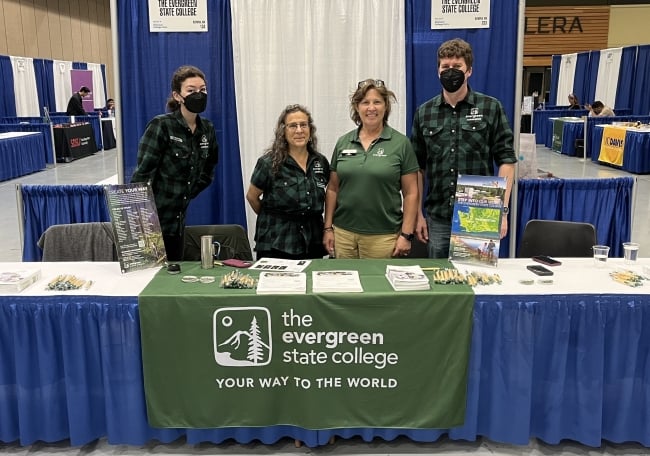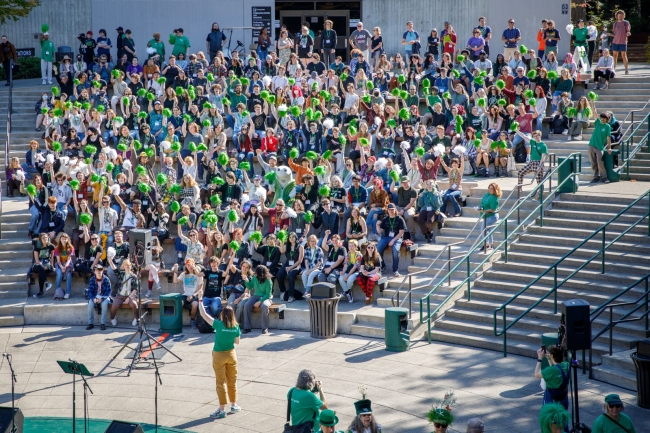You have /5 articles left.
Sign up for a free account or log in.

Evergreen State College professors Nancy Koppelman, second from left, and Bradley Proctor, far right, with two admissions officers at a meeting of the National Association for College Admission Counseling.
Bradley Proctor
For over a decade, enrollment at Evergreen State College has been on a steep and steady decline.
From 2011 to 2021, the public liberal arts institution in Olympia, Wash., famous for having no majors, saw its student body shrink by more than 50 percent, from 4,811 students to 2,026, according to publicly available institutional data.
But this fall, the college saw a flash of hope when it recorded its largest enrollment increase in 40 years: 23 percent year-over-year growth—building on 14 percent growth in 2022—bringing the college’s total head count to 2,225. So what made the difference?
It could be the slight pivot the college made in 2020, offering students “paths of study” to follow instead of the completely free-form model previously in place. It could be that the devastating impact of COVID-19 is finally fading; during the pandemic, the college’s enrollment dropped by nearly 600 students.
Or it could be because the faculty stepped in to help.
In the fall of 2022, Evergreen faculty got formally involved in the student recruitment process. Professors attended training sessions with admissions staffers to prepare them for a new role: meeting one-on-one with prospective students.
Bradley Proctor, an American history professor and one of two official faculty coordinators for the recruitment initiative, said faculty members were fully committed. Proctor himself took the fall semester off from teaching to focus on recruitment, attending strategy meetings with admissions officers; they even gave him an Evergreen Admissions jacket.
“We took care to be respectful of the amazing work they do in admissions and not step on any toes but really learn what we could offer,” he said. “The learning curve was definitely hard, but in the end we felt like part of the team.”
Evergreen president John Carmichael credits the initiative with spurring this fall’s large jump in enrollment.
“It was really all hands on deck,” Carmichael said. “We were starting to see more applications even before the pandemic, but what really moved significantly for us this year was yield, and I think faculty involvement at that stage in recruitment played a big part.”
The move was as much about saving jobs as it was about evangelizing Evergreen’s experimental model. In fact, the idea for the faculty recruitment collaboration came about during negotiations between the union and administrators over a potential reduction in force.
“When we were negotiating over the RIF, it wasn’t going easy, and neither side was happy about what it was looking like,” said faculty union president and media professor Julie Russo. “So we said, ‘We’re not interested in talking about cuts. We’re interested in talking about growth, and what we want is to actually be part of that process.’”
Enrollment as a Labor Issue
Falling enrollments have been a key factor in a wave of program cuts and faculty layoffs at public institutions this year, from regional institutions like Delta State University in Mississippi to once-invincible state flagships like West Virginia University.
Evergreen has cut dozens of faculty positions in the past five years, and in the 2021–22 academic year alone, 27 professors took early-retirement deals.
“Before we started growing, we did shrink,” Proctor said. “In some cases, because we don’t have majors, we lost entire departments when faculty left or were laid off. It’s been tough.”
An even more expansive reduction in force appeared imminent in 2022, Russo said, and avoiding that fate was the primary incentive for faculty to get involved in the recruitment process. The RIF was canceled in January, thanks in large part to positive application numbers generated by the new faculty recruitment initiative.
“Saving jobs is our No. 1 priority, and enrollment is really tied to that job security,” Russo said. “So for a while enrollment became [the union’s] No. 1 priority, too.”

Courtesy of Evergreen State College.
Making enrollment a labor issue also meant ensuring compensation for the extra recruitment work. Evergreen faculty contracts now list recruitment calls as one way to fulfill service and governance responsibilities, and faculty members who take on coordinator roles in the effort are able to cut back on their teaching loads.
Lee Furbeck, vice president for enrollment management at Stephen F. Austin State University and the author of a 2021 paper on faculty involvement in student recruitment, said there are plenty of reasons why the faculty may be wary of taking on recruitment roles. But enrollment declines and financial crises tend to dispel those doubts pretty quickly.
“You’re always going to find some folks who say, ‘That’s not my job; you’re not paying me to do that.’ Or you might run into those who are uncomfortable playing that kind of a brand ambassador role,” Furbeck said. “But any time there’s an enrollment crisis, there’s suddenly a lot of interest in assisting with recruitment.”
That’s true at Central Michigan University, where enrollments are finally plateauing after a decline of 43.5 percent over the past decade. In 2017 the university eliminated 30 vacant staff positions and laid off 24 employees, in addition to cutting back on faculty hiring.
Wade Tomson, associate admissions director at CMU, said he’s seen an increase in faculty reaching out to ask how they can help. Heidi Mahon, director of student services at CMU and the liaison between admissions and faculty, said the potential for further cuts has motivated professors to be part of the university’s enrollment strategy. Last year the university began offering Discover CMU days, during which dozens of faculty members have volunteered to demonstrate what Mahon calls “hands-on learning” to prospective students.
“There is definitely a sense of urgency, that it is important for everyone at the university to put their recruitment shoes on and hit the pavement,” Mahon said. “We all have a part to play.”
A Better Pitch From Eager Salesmen
It’s not just self-interest motivating faculty to recruit; Proctor said Evergreen faculty members had long been eager to speak with prospective students. He emphasized that they are not replacing admissions counselors but acting in a specific role: as translators and advocates for their college’s unique model of education.
Nobody can answer the most frequently asked questions from prospective Evergreen applicants better than the professors, Proctor argued: What does it mean to be free from the pressure of declaring a major? What kind of classes can students explore without a set degree pathway determining their schedules? How close are faculty-student bonds without the structure of a major adviser-advisee relationship?
Helping boost enrollment doesn’t always require faculty members to be directly involved in student recruitment. Furbeck said that some professors at Stephen F. Austin are lending their area expertise to the recruitment push, from a marketing professor training admissions staff in effective brand awareness to a design professor asking students to come up with creative visions for common spaces to appeal to visiting families.
Tomson said he anticipates more colleges will enlist faculty in the recruitment process going forward, especially at smaller institutions with a focus on professor-student relationships.
“Every student wants to feel that their institution truly wants them,” he said. “Everyone knows admissions counselors are the sales force of the university; that’s just our job. When the interest and engagement come from faculty, it’s different.”
At Evergreen, faculty recruitment responsibilities have been enshrined in a new collective bargaining agreement. Russo and Carmichael agreed that’s a good thing, since there will likely be a need for faculty involvement well into the future.
“It’s a real win for the entire institution that this is now a part of our contract, because the issues are not going away,” Russo said. “Evergreen is always going to be hustling for students; the days when we could rest on our laurels are behind us.”





